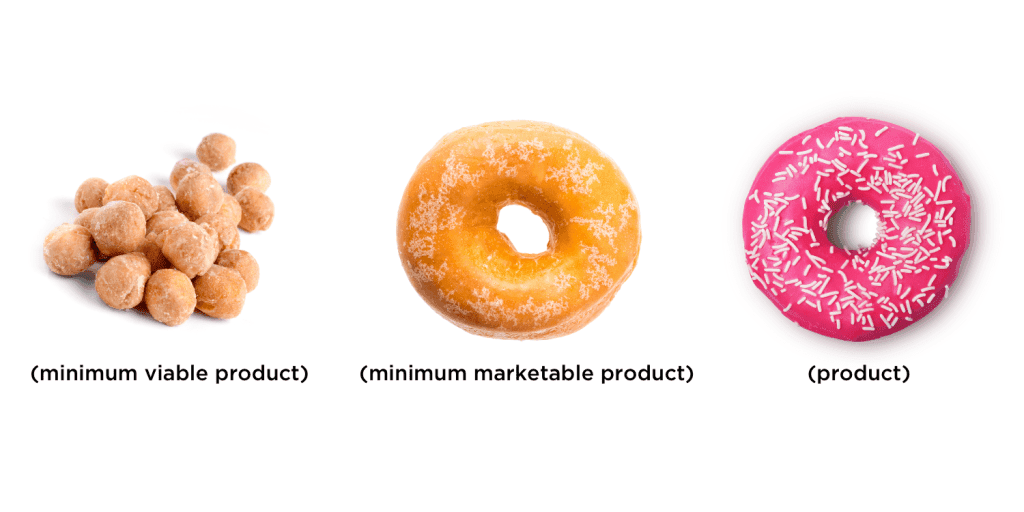When it comes to digital product development, you’ll more than likely be confronted with a whole host of acronyms and software development terminology like these, that can get pretty confusing to say the least. With so many different product development approaches and no "one size fits all" it can be a difficult landscape to navigate.
As part of our series on the digital product development process, our aim is to clear up some the confusion and define the meanings of MVP and MMP and explain the differences between the two.
What is a Minimum Viable Product (MVP)?
When you come up with an idea for an application, whether it be web or mobile, it can be really easy to get distracted and caught up on all the possible features that it will entail. Putting all those features together in one product is massively risky. Not only would it take a long time to develop, but if some of these features don’t resonate with your users- you’ll have wasted a lot of valuable time and money. Nobody wants that, right?
A Minimum Viable Product (MVP) was famously coined by Eric Reis in his book “The lean Startup” which emphasises the importance of learning and iteration in new product development. He defines the concept of an MVP as a
“version of a new product which allows a team to collect the maximum amount of validated learning about users with minimal effort”.
Typically, an MVP incorporates very basic features of a product enough to capture the attention of early adopters and allows you to capture feedback quickly and start the process of learning. An MVP is a “reduced down” version of your idea that validates a hypothesis.
Building an MVP can help you to:
Validate the entire business idea
Gain valuable insight on what works and what doesn’t work early on
Test the demand for your product before committing to full development
Reduce the investment risk and time to market
Establish a visible and defined roadmap for product development
What an MVP is NOT
An MVP (contrary to some opinions) is not a series of wireframes or a prototype, it’s a working piece of software that can be used and tested by real users.
On the other hand, a prototype is typically a visual representation of future product or idea that’s used to gain investment, persuade stakeholders and will represent a very general idea of how the product will work. Design prototypes can range from very basic sketches to fully clickable prototypes but cannot be released to market because it has no functionality yet.
What is a minimum marketable product (MMP)?
A Minimum Marketable Product (MMP) could be seen as the next practical step after MVP in the product development process.
While an MVP focuses on validating assumptions and learning about your users preferences, an MMP:
Incorporates a core set of functionalities that addresses customer/ user needs
Creates the desired user experience and can start creating quantifiable value for the business
Can be released to market with it’s must-have functionality that can then be scaled and developed to incorporate the “nice to have” functionality
Example of an MMP
A good example of an MMP is Apples very first iPhone which was developed and released in 2007.
What made this successful was that Apple stripped back the entire product to cater to a select set of customer needs. They avoided the pitfall of trying to please everyone at once and instead used the MMP as a product to build upon and extend the capabilities of the phone over time.
In contrast to an MVP, an MMP can be a version 1 of the app that you will release to the market. This will assume that you have completed the validated learning and have a solid understanding of your target users and preferences.

Going from MVP to MMP
Developing one or more MVP’s to test your ideas and acquire the relevant user and market knowledge will allow you to gain the insights you need to build the MMP. Every decision you make should depend on the results of the MVP validation. If the validation of your MVP is successful, shifting to building an MMP is the next stage in the process before focusing on final development of the product.
Adopting this approach is a win- win for both the business and the development teams. For the business, it means that you are creating a product that is based on validated knowledge which significantly reduces the risk of failure. For development teams, it means that they are not wasting time building out features that are irrelevant, or even detrimental, to a product.
Creating MVP’s and MMP’s create that trust between teams and ensures that everyone is on the same page with what is being built and why.
Need help with your digital product development journey?
Get in touch with the xDesign team for a chat.

